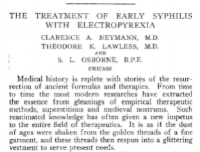More than skin deep: Theodore K. Lawless a Dermatologist, Scholar, and Philanthropist
When we learn about the history of medicine, rarely do we discuss important African American figures. This is especially true in dermatology, a medical specialty whose focus is the organ that defines race, but continues to be one of the least diverse specialties in medicine.(1) Despite the lack of diversity there have been many African American trailblazers who have shaped how we understand and treat skin disorders, particularly in skin of color. For Black History Month, I want to highlight the “skin wizard of the world,” Dr. Theodore Lawless, the first widely known African American dermatologist in the United States, who overcame prejudice and used his platform not only to advance medical science, but also to develop and give back to the community around him.(2)
Theodore Kenneth “T.K.” Lawless was born on December 6, 1892 in the small town of Thibodaux, Louisiana, later spending his childhood and adolescence in New Orleans. He began his college education at Straight University (now Dillard University) in New Orleans before transferring and ultimately graduating from Talladega College in Alabama in 1914. At the University of Kansas he could only complete the preclinical portion of his medical school training. Black people were barred from completing the clinical portion of training, which is required to graduate. As a result, Lawless transferred to Northwestern University in Chicago where he completed his MD in 1919 and MS in 1920.(3)
Dr. Lawless pursued further training in dermatology at Harvard; however, he ultimately completed his dermatology studies in Europe, perhaps due to the friendlier racial climate. While in Europe between 1921-1924 he had yearly stints at three institutions: St. Louis Hospital in Paris, France; the University of Freiburg in Freiburg, Germany; and Kaiser Joseph Hospital in Vienna, Austria.(3)
Upon his return from Europe, Dr. Lawless established a thriving practice on the south side of Chicago. He was known for his generosity, treating patients regardless of class or race. His medical clinic was one of the largest dermatology clinics in Chicago. Men, women, and children of all races packed his clinics, waiting rooms, and even the street outside of his offices. He quickly gained reputation for his excellent clinical abilities.
In addition to founding a private practice, Dr. Lawless also had a productive but sometimes contentious role as faculty at Northwestern University from 1924-1941. He was the first African American certified by the American Academy of Dermatology and Syphilology (today the American Academy of Dermatology). He published widely, including on the application of electropyrexia for syphilis, which appeared in the Journal of the American Medical Association, a prominent medical journal whose parent organization, the American Medical Association, openly prohibited African Americans members. Despite his many contributions in research and medicine he was not appropriately promoted at Northwestern because of his race and the insecurities some doctors felt, in part, due to his intellectual prowess.(3)
When he left Northwestern, Dr. Lawless expanded his focus beyond medicine to business. Most notably he became involved in banking and helped black businesses in Chicago seeking financing. He even actively participated in real estate, developing a middle-income housing project (now low income), which bears his name. His successes ultimately made him one of the richest black people in America; he appeared on Ebony magazine’s list of ‘America’s 35 Negro millionaires’. Despite his business success he continued to see patients and never turned away those who could not pay.
His philanthropy notably extended to the Jewish community. He established the Lawless Clinical and Research Laboratory in Dermatology at the Hebrew Medical School in Jerusalem and created the Department of Dermatology in Beilinson Hospital, Tel-Aviv, Israel. Dr. Lawless felt a deep sense of gratitude and indebtedness to the Jewish community because Jewish physicians were the only ones willing to support him during his medical training. Of the 12 recommendations he needed to study dermatology in Europe, 11 came from Jewish physicians.
In 1954, Dr. Lawless’s many accomplishments resulted in his receipt of the 39th NAACP Moorland-Spingarn medal for pioneering achievements. Only four physicians have been awarded this prize in the 100-year history of the award, which recognizes outstanding achievement by African Americans. Dr. Lawless continued to work until his death on May 1st, 1971 at the age of 78. He was a true giant and pioneer in the field of dermatology and should be celebrated for his commitment and contribution not only to the field, but also to his community at large. With the recent calls for increasing diversity in dermatology it will also be important to highlight the accomplishments of African American dermatologists, especially during Black History Month.(1)(4)
References:
Pandya AG, Alexis AF, Berger TG, Wintroub BU. Increasing racial and ethnic diversity in dermatology: A call to action. J Am Acad Dermatol. 2016;74(3):584-587.
Kelly AP, Taylor SC, Lim HW, Anido Serrano AM. Taylor and Kelly's dermatology for skin of color. Second edition. ed.
Cobb WM. Theodore Kenneth Lawless, M.D., M.S., D.Sc., LL.D., 1892. J Natl Med Assoc. 1970;62(4):310-312.
Imadojemu S, James WD. Increasing African American Representation in Dermatology. JAMA Dermatol. 2016;152(1):15-16.


